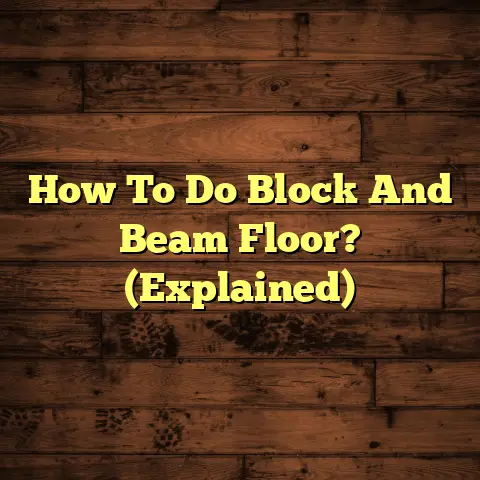Pergo Underlayment Needed? (The TRUTH Revealed!)
Ever walked into a home with stunning Pergo floors, and wondered if they really needed that underlayment?
I know I have! It’s a question that pops up all the time.
Is it just another upsell, or is it crucial for a successful Pergo installation?
I’m John, a flooring contractor with over 15 years of experience.
I’ve seen it all when it comes to flooring.
And trust me, I’ve got some stories to share!
Today, we’re diving deep into the world of Pergo underlayment.
We’ll uncover the truth, bust some myths, and help you make the best choice for your project.
Ready to get started? Let’s jump in!
Understanding Pergo Flooring
First things first, let’s talk about Pergo.
What is it, exactly?
Pergo is a type of laminate flooring.
It’s designed to mimic the look of hardwood, tile, or stone.
But it’s made from composite materials.
This makes it more affordable and durable than many natural options.
Think of it as a high-tech sandwich.
It usually has a wear layer on top for protection.
Followed by a decorative layer that gives it its look.
Then there’s a core board, often made of high-density fiberboard (HDF).
This gives the flooring its strength and stability.
Pergo is known for its durability, ease of maintenance, and wide range of styles.
I’ve installed Pergo in everything from busy family homes to light-traffic offices.
It’s a popular choice for good reason!
What is Underlayment?
Okay, so we know Pergo. Now, what about underlayment?
Simply put, underlayment is a thin layer of material.
It goes between your subfloor (the foundation) and your finished floor (Pergo).
Think of it as a cushion or a barrier.
It’s usually made of foam, cork, rubber, or felt.
Each material has its own pros and cons.
Underlayment serves several important functions:
- Sound Absorption: It reduces noise from footsteps and impact.
- Thermal Insulation: It helps to keep your floors warmer.
- Moisture Protection: It acts as a barrier against moisture from the subfloor.
- Subfloor Imperfection Compensation: It can smooth out minor bumps and dips.
I’ve seen firsthand how underlayment can transform a floor.
It can make a huge difference in comfort and sound.
The Role of Underlayment with Pergo Flooring
Now, let’s get specific.
How does underlayment work with Pergo flooring?
It builds on the benefits I mentioned earlier.
Sound Absorption:
Pergo, like other laminates, can sometimes sound “hollow” when you walk on it.
Underlayment absorbs some of that sound.
It makes the floor feel quieter and more solid.
I’ve had clients tell me it’s like night and day.
Thermal Insulation:
If you have a cold subfloor, underlayment can help insulate your Pergo floor.
This can make your room feel warmer and more comfortable.
Especially during those chilly winter months.
Moisture Control:
Moisture is the enemy of laminate flooring.
Underlayment can act as a barrier.
It prevents moisture from seeping up from the subfloor.
This can protect your Pergo from warping or damage.
Subfloor Imperfection Compensation:
No subfloor is perfectly level.
Underlayment can help smooth out minor imperfections.
It creates a more even surface for your Pergo.
This can prevent your floors from feeling uneven or unstable.
The Debate: Is Underlayment Necessary?
Here’s the million-dollar question: Is underlayment really necessary for Pergo?
The answer, as with many things in life, is: it depends.
There are definitely situations where it’s highly recommended.
And others where you might be able to get away without it.
Arguments FOR Underlayment:
- Enhanced Comfort: Makes the floor feel softer and more comfortable to walk on.
- Improved Sound Insulation: Reduces noise and echo in the room.
- Moisture Protection: Protects the Pergo from moisture damage.
- Extended Lifespan: Can help to prolong the life of your Pergo floor.
Arguments AGAINST Underlayment:
- Added Cost: Underlayment adds to the overall cost of the project.
- Potential for Overkill: If your subfloor is already level and dry, it might not be necessary.
- Built-in Underlayment: Some Pergo products come with underlayment already attached.
I’ve talked to homeowners who skipped underlayment to save money.
Some regretted it, citing noise issues or discomfort.
Others were perfectly happy with the results.
I’ve also spoken with installers who always recommend underlayment.
They believe it’s a small price to pay for long-term protection and satisfaction.
Here’s a table that summarizes the Pros and Cons of using Underlayment.
Ultimately, the decision is yours.
But it’s important to weigh the pros and cons carefully.
Manufacturer Recommendations
So, what does Pergo say about all this?
Let’s take a look at their official recommendations.
Generally, Pergo recommends using underlayment.
Even if your chosen Pergo flooring has a pre-attached underlayment, there are circumstances where an additional layer is beneficial.
Here’s why:
- Warranty Requirements: In some cases, using an approved underlayment is required to maintain your Pergo warranty.
- Specific Subfloor Conditions: Pergo might recommend a specific type of underlayment for certain subfloor conditions (e.g., concrete slabs).
- Enhanced Performance: Even with pre-attached underlayment, adding an extra layer can improve sound insulation or moisture protection.
I always advise my clients to read the Pergo installation manual carefully.
Pay attention to any specific recommendations or requirements.
Also, check the warranty information.
Using the wrong underlayment (or no underlayment when required) could void your warranty.
Case Studies
Let’s get real for a moment.
Here are a few real-life examples of homeowners and their Pergo underlayment experiences:
-
Case Study 1: The DIYer Who Skipped Underlayment
Sarah installed Pergo in her spare bedroom to save some money.
She skipped the underlayment because her subfloor seemed level.
However, she quickly noticed that the floor felt hard and sounded echoey.
She regretted not spending the extra money on underlayment.
-
Case Study 2: The Sound-Sensitive Family
The Johnsons installed Pergo in their living room.
They have young children and wanted to minimize noise.
They chose a high-quality underlayment specifically designed for sound absorption.
They were thrilled with the results.
The floor was quiet and comfortable.
-
Case Study 3: The Moisture-Prone Basement
Mark installed Pergo in his basement.
He knew that basements can be damp.
So he chose an underlayment with a built-in moisture barrier.
He hasn’t had any issues with moisture damage.
These examples show how different situations can call for different approaches.
There’s no one-size-fits-all answer when it comes to Pergo underlayment.
Cost Analysis
Let’s talk money.
How much does underlayment actually cost?
And is it worth the investment?
The cost of underlayment varies.
It depends on the material, thickness, and brand.
Generally, you can expect to pay anywhere from $0.50 to $2.00 per square foot.
Here’s a quick breakdown:
- Basic Foam Underlayment: $0.50 – $1.00 per square foot
- Cork Underlayment: $1.00 – $1.50 per square foot
- Rubber Underlayment: $1.50 – $2.00 per square foot
Now, let’s compare the cost of installing Pergo with and without underlayment:
Let’s assume you’re installing Pergo in a 200 square foot room.
As you can see, underlayment can add a significant cost to your project.
But consider the long-term benefits.
If underlayment prevents moisture damage or extends the life of your floor, it could save you money in the long run.
Conclusion: The Final Verdict
Alright, we’ve covered a lot of ground.
So, is underlayment necessary for Pergo flooring?
My professional opinion?
It’s highly recommended in most cases.
While you might be able to get away without it in certain situations, the benefits of underlayment usually outweigh the cost.
Here’s a quick recap of the key takeaways:
- Underlayment provides sound absorption, thermal insulation, and moisture protection.
- Pergo generally recommends using underlayment, especially for warranty purposes.
- The best type of underlayment depends on your subfloor conditions and personal preferences.
- Consider the long-term cost savings of using underlayment.
Ultimately, the decision is yours.
But I hope this article has given you the information you need to make an informed choice.
Call to Action
Now it’s your turn!
What are your experiences with Pergo underlayment?
Have you ever skipped underlayment and regretted it?
Or have you found it to be a worthwhile investment?
Share your thoughts and opinions in the comments below!
Let’s learn from each other and help everyone make the best flooring decisions possible.
And if you’re planning a Pergo flooring project, I encourage you to consider all the factors we’ve discussed today.
Good luck, and happy flooring!





